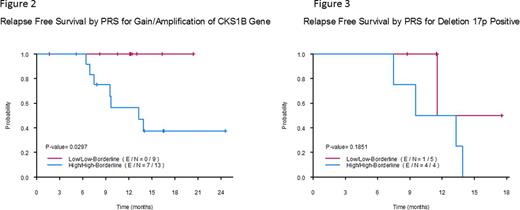Abstract
Introduction: Multiple Myeloma is a heterogeneous cancer that affects the bone marrow. Given this heterogeneity, we aimed to elucidate the role of gene expression profiling (GEP) in identifying different MM subtypes and explore their relationship to clinical outcomes in a standard of care setting.
Methods: We retrospectively analyzed all NDMM patients with baseline GEP analysis. 55 patients from April 2014 until March 2016 were identified and included in our analysis. GEP was performed using CD138+ cells from bone marrow samples through MyPRS® (Signal Genetics, Little Rock, AR). Fisher's exact test was used to evaluate the associations between two categorical variables. The Wilcoxon rank sum test was used to evaluate the difference in continuous variables between patient groups. Kaplan-Meier method was used to estimate the time to event endpoints including relapse free survival (RFS) and overall survival. The log-rank test was used to evaluate the differences in the time to event endpoints between/among patient groups. Univariate Cox proportional hazards model was used to evaluate the association between a continuous variable and relapse free survival.
Results: Median age was 61 (38-76). Patients presented with lytic lesions (80%), anemia (78%), kidney dysfunction (24%) and hypercalcemia (31%). One patient did not meet CRAB criteria, but had 60% plasma cells in the bone marrow and an involved/uninvolved sFLC ratio of 199. All patients were treated with bortezomib (88%) or carfilzomib (12%) initial therapy in combination with lenalidomide (83%) or cyclophosphamide (17%). All patients received triple therapy as initial treatment, with 60% of patients receiving an upfront autologous transplant. With median follow-up of 12 months (1.64-24.54 months) 75% of patients had not relapsed and median overall survival had not been reached. 13 (24%) patients were characterized as high risk (HR) by GEP. GEP risk category predicted RFS (p=0.0014) in this series of patients (Fig. 1). Table 1 shows GEP risk subtypes with clinical outcomes and association to FISH abnormalities. We previously reported that HR FISH abnormalities are present in GEP low risk (LR) patients. LR GEP patients with CKS1B gene gain by FISH (n=9, 23%) had 100% RFS at 21 months, while 60% of HR GEP patients with CKS1B gene gain had relapsed by 24 months (p=0.0297, Fig. 2). All patients with HR GEP and 17p deletion relapsed by 14 months whereas only one patient with LR GEP and 17p deletion died 1 year from diagnosis, with an unknown cause of death (p=0.18, Fig. 3).
Conclusion: Cytogenetics and FISH are still the current standard of care to predict prognosis in NDMM, direct care and inclusion in clinical trials. This study in a standard of care setting shows that GEP further refines prognosis in patients with HR FISH abnormalities. Future studies in larger cohorts of patients are warranted to confirm our findings.
No relevant conflicts of interest to declare.
Author notes
Asterisk with author names denotes non-ASH members.




This feature is available to Subscribers Only
Sign In or Create an Account Close Modal